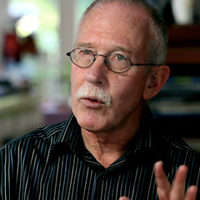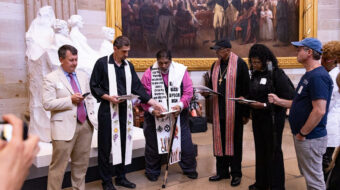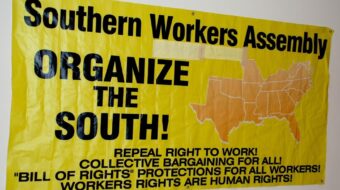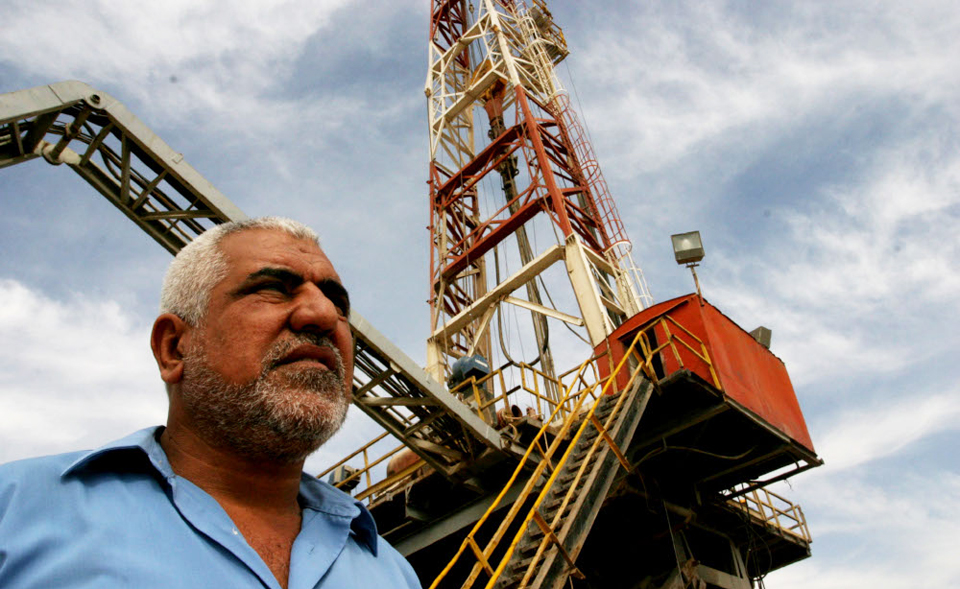
The U.S. media quickly dismissed the results of Iraq’s national elections on May 12. Journalists were puzzled by what the followers of Muqtada al-Sadr and the Iraqi Communist Party (ICP) might have in common, and even more, by why they garnered more Iraqi votes than any other electoral list.
Al-Sadr’s Mahdi Army fought the U.S. early in the occupation, and his political base is mostly among poor and disenfranchised Iraqis, especially in Baghdad’s Sadr City. This vast neighborhood of 3.5 million people, half the population of Baghdad, was known originally as al-Thawra, or Revolution, built for poor people migrating from the countryside by radical nationalist Prime Minister Abdul Karim Qassim in 1959. For many years it was a stronghold of the ICP. Later, after the Baathist coup that overthrew Karim Qassim and eventually brought Saddam Hussein to power, it was renamed Saddam City. Then, after the 1999 assassination of Muqtada al-Sadr’s father, Ayatollah Mohammad Sadeq al-Sadr, it became popularly known as Sadr City.
The New York Times labeled Muqtada al-Sadr’s partners in the Sairoon coalition “Iraq’s moribund Communists, Sunni businessmen and pious community activists.” Actually, besides al-Sadr and the ICP, Sairoon (meaning Forward or the Alliance for Reforms) includes the Youth Movement for Change Party, the Party of Progress and Reform, the Iraqi Republican Group, and the State of Justice Party.
Oversimplifying politics and ignoring history, however, is not just a matter of names. It reveals blindness to the long process in which Iraqi civil society has been rebuilding itself, to the popular anger that has motivated this, and to the growing support for the political alternative this alliance proposes.
The 329 parliamentary deputies chosen in the May election will vote for a new prime minister. Sairoon won the most 55 deputies, with 1.3 million votes. It was followed by the Fatah Party of Hadi al-Amiri, whose base rests on militias with ties to Iran, with 47 seats and 1.2 million votes. Voters rejected the parties of both the current Prime Minister Haidar al-Abadi (Victory Coalition with 40 seats) and former Prime Minister Nouri al-Maliki (State of Justice Party with 25). Turnout was low, at 44 percent nationwide and only 33 percent in Baghdad itself (where Sairoon won 23 percent, almost twice that of any of its rivals).
The program of the Sairoon alliance calls for an end to the system that divided political positions and government support along sectarian lines, a system imposed by the U.S. after its occupation of Iraq in 2011. Basing a governmental structure on sectarian political parties led to a system of patronage and division of spoils, and consequently enormous corruption. Al-Sadr explained, “I’ll say this despite the amama [turban] on my head. We tried the Islamists and they failed miserably. Time to try independent technocrats.”
Sairoon also called for independence from foreign domination by the U.S. and Iran. In advance of the election, a senior Iranian politician, Ali Akbar Velayati, visited Iraq and threatened Iranian reprisals if voters chose Sairoon: “We will not allow liberals and communists to govern in Iraq,” he said. Many secular politicians condemned the statement as interference in Iraq’s internal affairs.
Following the election, because no group got anywhere near a majority, negotiations began between Sairoon and two runners-up, al-Amiri’s Fatah bloc and al-Abadi’s Victory Coalition. Inside Sairoon this has produced tension between the Sadrists and the ICP. Some coalition members are calling for it to go into opposition rather than agree to power-sharing with parties and politicians still committed to the hated sectarian quotas.
ICP’s general secretary, Raid Jahid Fahmi, however, says the Sairoon alliance has a strong natural basis. “The social base is quite close-the social base of the left and the social base of the Sadrist movement,” he explained. In the Shiite holy city of Najaf, one of the country’s most conservative, voters elected a Communist woman representing the Alliance. Suhad al-Khateeb, a teacher, anti-poverty, and women’s rights activist, explained, “We were never agents for foreign occupations. We want social justice, citizenship, and are against sectarianism, and this is what Iraqis also want.”
The coalition is more, though, than an agreement between Communists and Sadrists. It developed from a popular civic movement on the Iraqi streets, with roots in protests going back to 2010, and in the growth and popularity of the country’s unions.
Iraqi Spring
In summer 2010, as temperatures soared past 120 degrees, Iraqis came out of their homes to protest the lack of electricity. Since the start of the occupation in 2003, U.S. authorities, and later the Iraqi government, have been unable to provide power around the clock, especially during periods of high demand. That failure was due in part to contracts granted by the U.S. occupation to foreign corporations for rebuilding the electrical grid destroyed by the war. Private foreign contractors often sold Iraq equipment incompatible with its own system, and then pulled out. When they criticized reliance on these contractors, the leaders of the new union for the industry’s workers were arrested.
Protests continued the following year, 2011. Through February, as Arab Spring demonstrations took place throughout the Middle East, young Iraqis began organizing rallies in Tahrir Square in Baghdad, mostly calling for jobs and better electrical service. They called their actions the Iraqi Spring. One general, Abdul Aziz al-Kubaisi, even tore off his military rank insignias on television and said he was joining young people in the streets. Former Prime Minister Nouri al-Maliki, just put into power by the U.S., called them all “insurgents and terrorists.”
Forty-five people died in the ensuing repression, including 29 on February 25, the Day of Rage. Hundreds were arrested. Protests continued throughout the spring, and on April 9 thousands filled Tahrir Square and streets in other cities. In May, al-Sadr organized yet another demonstration of tens of thousands of people.
Since that Iraqi Spring, Friday has been the day most often chosen for marching in the streets. In 2015, Iraqis began demonstrating every Friday, denouncing the corruption of sectarian political parties, holding it responsible for the crisis in providing electrical power, clean water, and other basic services.
Editors of the Iraqi Civil Society Solidarity Initiative website described those initial 2015 protests:
The demonstrators, mostly youth and civil society activists, challenge the political system as a whole, call for a secular state in opposition to a confessional state, against the division between Sunni and Shi’a populations, [and] for women’s rights and workers’ rights … Iraqi women’s rights groups are actively working to make sure women can take part in the demonstrations without being harassed.” Young people held banners with fiery slogans: “The Parliament and the Islamic State are two sides of the same coin!” “Daesh was born out of your corruption!” “Humans do not survive with religion but bread and dignity!” “In the name of religion, they act like thieves!” And “No to sectarianism, no to nationalism, yes to humanity!”
In April 2016 protestors occupied the Iraqi Parliament building in the Green Zone, demanding an end to the sectarian political system, and left only after government officials promised electoral reforms. Then last year, on February 11, thousands of people began a non-violent march from Tahrir Square to the Green Zone, demanding reform of the electoral commission, charging that it was dominated by the Dawa Party of former prime minister al-Maliki. Jassim al-Hilfi, one of the civil society protest organizers and an ICP leader, explained that participants had three demands: reform of the political system, combating corruption, and provision of services.
Government Special Forces troops, wearing black uniforms, fired on the protestors as they crossed the Al Jumhuriyah Bridge. Nine people were killed and 281 were wounded. Eight of the dead were unarmed, and one was a policeman trying to protect demonstrators from the soldiers shooting them. Joint press conferences by the followers of al-Sadr and the Madaniyoon (Civil) Movement denounced the killings. In subsequent memorial marches people also carried the symbolic coffin of Hadi al-Mahdi, assassinated in 2011 in the Maliki government’s suppression of that year’s popular rebellion.
Over time, the growing protest movement “provided a program for political reform,” according to Benedict Robin, a PhD student in Britain who follows Iraqi politics. “This centered on breaking the grip of sectarianism and party factionalism on governing structures by introducing independent technocrats as ministers. Other proposals included reform of the civil service to set government ministries outside of party political patronage, reforming the electoral law, the judiciary, and issues of economic and social justice.”
Role of Iraqi unions
The demand for non-sectarianism reflects a long tradition in Iraqi unions as well, which have never been organized on sectarian lines. Most, like the powerful Iraqi Federation of Oil Employees, have written non-sectarianism into their bylaws, although pictures of Muqtada al-Sadr can be found in many oil workers homes.
The Iraqi labor movement was organized in the 1920s in the oil industry and among railroad workers, and for decades the country was the most industrialized in the Middle East. Its unions, part of a strong leftwing political culture, helped overthrow the British-installed king and establish Karim Qassim’s nationalist and socialist government in the 1950s. That was overthrown in a Baathist coup, and Saddam Hussein eventually took power with the support of U.S. intelligence agencies. He, in turn, suppressed leftwing parties and only permitted weak unions controlled by the government.
That didn’t earn the U.S. much loyalty among Iraqi labor activists, many of whom returned from exile after the overthrow of Saddam. Nevertheless, they were prepared to give the U.S. the benefit of the doubt, especially after a wave of assassinations by remnants of the old Mukhabarat secret police allied with rising groups of religious extremists. Under the Bush-era occupation, however, U.S. authorities prioritized the privatization of Iraqi industry, while keeping unions and the left marginalized.
Until 2015 Iraq still had on the books the Saddam Hussein-era Law 150, prohibiting unions among public workers. In Iraq that sector includes the oil, gas, electricity and many other industries. In 2010, the government of Nouri al-Maliki reinforced Law 150 with Ministerial Order 22 244, which held unions illegal under the country’s terrorism laws. From the start of the occupation in 2003 until a new law was passed in 2015 workers had to organize despite the illegal status of their unions. The 2015 law gave all workers the right to form unions, except for direct government (civil service) employees and security and police forces, for whom Law 150 still applies. Unions gained collective bargaining rights and the right to strike. Last year the al-Abadi government promulgated a further Draft Law on Professional Federations and Unions, but labor has opposed it, saying it failed to completely guarantee workers’ rights.
Hassan Juma’a, head of the Iraqi Federation of Oil Employees, said the draft was “motivated by political forces that do not want the independence of trade union organizations and do not believe in trade union pluralism, especially in the public sector.” Nevertheless, earlier this year unions convinced the government to finally ratify ILO Convention 87 on Freedom of Association, which they view as a step towards legislation that will finally guarantee union rights for all Iraqi workers.
In April last year, 3,000 contingent workers in the electrical generation and transmission industry formed a union, after the government failed to pay their wages for five months. They then joined with the union for the industry’s permanent workers to form the General Trade Union of Electricity Sector Employees of Iraq. This March, they began a series of demonstrations in Baghdad and Basra. On March 29, the government electrical ministry fired 100 of the union’s leaders, saying they’d been absent from work during the previous day’s protest. Some had been working in the generating stations for over 10 years. Two days later, workers began sit-ins in power plants across Iraq. Their demands included reinstating the fired laborers, permanent jobs and inclusion in Iraq’s Social Security system, and a minimum monthly wage of $300.
On May 18, just after the election, the Iraqi government announced that it would not only include all 30,000 contingent contract workers in the electricity industry in the Social Security system but would guarantee the same rights as those enjoyed by permanent workers to the 150,000 contract workers throughout the public sector.
Hashmeya Alsaadawe, president of the Basra Trade Union Federation and the electrical union-the first woman to head a national union in Iraq-said that the elections had encouraged people to demand that they benefit from the country’s oil wealth. “Workers have high expectations,” she said. “They have been very active in demonstrations and on social media to demand their rights.”
Those heightened expectations and worker demonstrations dealt a blow as well to the World Bank, which had threatened the Iraqi government that it would not grant critical loans without reduced government spending on social benefits. Under bank pressure, last year the Iraqi cabinet then approved a draft social security law that would have increased worker contributions to the funds while raising the retirement age from 63 to 65. “Adoption of this draft will lead to increased poverty among Iraqis, even though they are living in one of the world’s richest countries in oil,” Alsaadawe charged.
Workers in the critical oil and gas industry in December finally formed a national network of eight previously competing unions. According to Hassan Juma’a, “One of the most important priorities is the unity of the trade union movement in Iraq. We have started the first step in the most important sector, the oil and gas sector. This network gives us a unified force capable of defending workers’ rights and protecting national production.”
The network’s objectives include defending the rights of contingent and migrant workers, who make up a significant part of the industry workforce. Its nationalist spirit is evident in its commitment to “protect national wealth for future generations against capitalist companies that do not respect the rights and opinions of citizens,” and “to urge foreign companies to take responsibility for maintaining the infrastructure of areas near oil fields exposed to toxic emissions.”
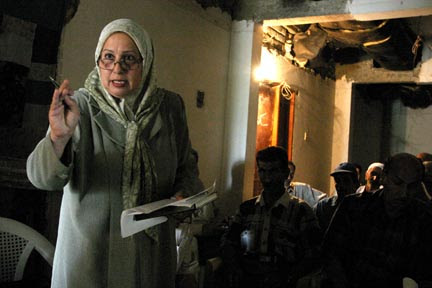
Iraq today has six union federations. One, the General Federation of Iraqi Workers, is allied with the ICP, and another, the Federation of Workers Councils and Union in Iraq, was organized by members of the Iraqi Workers Communist Party. The country’s main oil workers union, the Iraqi Federation of Oil Unions, is independent. The Kurdistan United Workers Union united Kurdish unions in 2010, and the other two federations are smaller groups that existed under Saddam Hussein.
Iraqi unions and federations do not bind their members to support of individual political parties. According to Wesam Chaseb of the AFL-CIO-linked Solidarity Center, “They are the real face of Iraq. There is no discrimination among workers.” Unions do not use the candidate endorsement system used by U.S. unions, but some individual union leaders also play roles in political parties, and unions encourage their members to vote for candidates who support workers’ demands.
Dhiaa al-Asadi, the director of Muqtada al-Sadr’s political office, told the Al-Monitor news website that the Sairoon list is “a reform project that represents the hopes and expectations of deprived and less advantaged people. This project of Sairoon constitutes a paradigm shift and a departure from the established norms that have characterized the political process since 2003.”
This combination of street protests, electoral activism and increasing union strength is one of the most important features of Iraq’s political landscape, as Iraqis seek to rebuild their country after four decades of war, the deaths of millions of people, and a bitter decade of foreign occupation and domination. A growing progressive alliance, recovering its oil wealth, could make Iraq a country to be envied by its neighbors instead.


